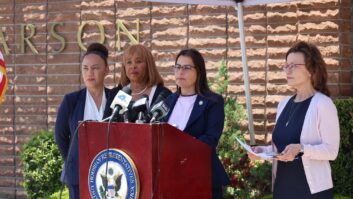WASHINGTON The process of drawing a roadmap to develop an enhanced public warning infrastructure is gaining momentum thanks to a renewed collaboration among stakeholders in the new Emergency Alert System.
And for the first time, FEMA officials have acknowledged they will not implement any new system that will require broadcasters to purchase new equipment until enough updated equipment is available from suppliers to meet demand.
The Federal Emergency Management Agency is implementing several projects simultaneously to modernize and integrate EAS and National Alert and Warning System (NAWAS) programs into a national-level all-hazards warning system. Collectively these systems will constitute the Integrated Public Alert and Warning System, or IPAWS.
Meanwhile, FEMA’s adoption of the Common Alerting Protocol standard — a text-based, detail-rich system that local and state emergency managers will use to generate public warning messages — appears to be getting closer.
CAP permits a warning message to be disseminated simultaneously over many different warning systems and ultimately allows the president of the United States to address the nation during a national emergency.
FEMA has yet to settle on what the final CAP architecture will look like, but it’s nearing a process to migrate EAS to become CAP-capable, said Wade Witmer, acting director of the IPAWS program management office at FEMA.

FEMA officials provided this illustration of how IPAWS is intended to enable alerts to reach the public through as many means as possible. “We intend to adopt the OASIS CAP v1.2 when OASIS finishes its work,” Witmer said.
OASIS — the Organization for the Advancement of Structured Information Standards — is seeking public review and comment on CAP Version 1.2. OASIS was founded in 1993 and has more than 5,000 participants representing some 600 organizations in 100 countries. The not-for-profit consortium helps drive development, convergence and adoption of open standards.
Its Emergency Management Technical Committee received 75 comments from a public review earlier this year. The group discussed and categorized those comments before launching a second public review period in May that continues through July 27.
FEMA hopes to adopt CAP v1.2 sometime during the first quarter of 2010, Witmer said. The agency had originally hoped to adopt and publish a CAP profile sometime in the first quarter of this year.
“There has been so much work done already. We are not that far from pushing it over the edge and getting it to work,” said Witmer, who was named acting director of IPAWS in January.
Witmer has set clear milestones to be achieved before the agency will adopt a final version of CAP. Those include establishing conformance labs to begin CAP testing, demonstrating the delivery of a federal message in CAP to a national Primary Entry Point station and starting the OASIS process for a CAP security profile.
FEMA expects soon to choose a contractor to run lab testing this summer, to examine manufacturers’ equipment and determine how close the gear is to the desired profile, Witmer said. He expects equipment trials to begin in August.
Diversification of EAS to include multiple communication media is at the heart of the EAS upgrade, Witmer said. Capability to interact with highway reader boards, the Internet, cell phones and other electronic devices is a top priority of FEMA.
“We need to integrate multiple pathways for emergency managers to communicate information.”
Federal agencies involved in public alerting, including the Federal Communications Commission and National Weather Service, are moving forward through the CAP adoption process, according to sources familiar with recent developments.
National Weather Service offices nationwide have begun a phased implementation of text markers within their alerts to indicate the “call to action” statement that allows downstream CAP application software to extract information for their instruction fields, they said. NWS officials expect to begin generating full CAP messages by late 2010 or 2011.
The FCC is ready to rewrite Part 11 of its rules but doesn’t want to do so until FEMA is about 60 to 80 percent through the CAP technology and implementation process, Witmer said.
A Renewed Trust CAP appears to have won ample support among public warning professionals.
“I have great hopes for CAP. It’s been about 10 years since I first heard Art Botterell explain CAP and its potential,” said Adrienne Abbott, chair of the State Emergency Communications Committee for Nevada.
Botterell is considered to be the architect of CAP Version 1.1 and is manager of a community warning system for the Sheriff’s Department of Contra Costa County in California.
Abbott said CAP seems to be the ideal solution to the problems an emergency manager encounters when faced with sending urgent notifications.
“CAP messages can come with maps for evacuations routes (on TV) and messages in various languages. It can spread information across many platforms.”
Also clearly visible is a renewed sense of trust between EAS stakeholders and FEMA now that Wade Witmer is acting director of the IPAWS program management office there.

Wade Witmer is acting director of the IPAWS program management office at FEMA
“FEMA is being diligent in soliciting the best data and best ideas available,” said Gary Timm, broadcast chair of the Wisconsin SECC. “It’s a new direction in the IPAWS mission for them to be considering the needs of state and local emergency managers.”
Most EAS experts contacted by Radio World see another positive in President Obama’s choice of Craig Fugate as the next director of FEMA.
Fugate is considered to be a “public warning professional,” said those interviewed for this story. He spent 15 years as assistant director and director of the Florida Division of Emergency Management.
With new leadership in place at FEMA, the agency can now focus on CAP, which is seen as a “hugely integral piece” to IPAWS, said Clay Freinwald, chairman of the SBE EAS Committee.
“I’ve never seen so many moving parts in motion at one time as I do right now,” Freinwald said. CAP, he said, “is the common language that solves a myriad of issues and problems with the current EAS. Think of CAP as a big database that allows people to pull out fields of information they need and plug it into their system to create a message.”
Some emergency alerting experts, because of FEMA’s previous reluctance to release details, have referred to CAP as “vaporware.” That attitude is changing, Freinwald said. “We can tell that CAP is clearly taking shape now.”
A CAP roadmap is coming into view, concurred Suzanne Goucher, president of the Maine Association of Broadcasters and the state’s EAS committee chair. “What it will look like and how the message will be distributed and authenticated is becoming clearer,” she said.”They do not want to write policy that will drive implementation or drive us into something we do not want to implement.”
Some time on gear
Much has been made of the FCC’s 2007 Second Report and Order on an improved EAS, which stipulated that broadcasters must have the ability to accept a CAP message within 180 days of FEMA officially adopting an enhanced EAS protocol. Some manufacturers and broadcasters have questioned equipment availability in such a short time frame.
Darryl Parker, senior vice president of TFT Inc., said, “We are working towards that goal (of early 2010) and will do our best to produce enough equipment to satisfy demand.”
TFT participated with other manufacturers in an ad hoc working group that published a CAP profile that was largely accepted by FEMA. TFT already has a device for translation of CAP messages into EAS protocol, Parker said.
“The item can be added to an existing EAS system in much the same fashion additional receivers are now,” Parker said.
Some EAS experts speculate that broadcasters and manufacturers will not hesitate to ask FEMA and the FCC for more time if it’s needed to develop CAP-compliant equipment for the next generation of EAS.
“I hope to see everything up and running only after all the issues related to the new EAS are resolved so that we don’t end up with a product that still needs to be baby-sat for 24/7,” said Adrienne Abbott, chair of the State Emergency Communications Committee for Nevada and a field engineer for the Nevada Broadcasters Association.
Broadcasters, Abbott said, “will be spending a lot of money on new equipment and the last thing our stations need is a $5,000 dinosaur trampling through our new and improved high-tech world.”
Witmer said FEMA will not start the 180-day clock with formal adoption until it is convinced broadcasters will be able to comply and purchase the new equipment required.
“The FCC has also plainly stated that any broadcaster not ready (for CAP) can apply for a temporary waiver,” Witmer said.
A more economical solution to CAP compliance could be found in a radio station’s studio automation system. A person familiar with recent CAP developments said at least two radio automation equipment manufacturers are working to develop a software upgrade to allow automation systems to import and forward CAP alerts.
“These systems use XML [Extensible Markup Language] files all the time. A system could accept a CAP message and create a program on the fly,” the source said. “It could be a $500 fix instead of $2,500.”
RBDS and more
FEMA’s roadmap to a new EAS, Witmer said, will include multiple pathways to reach more people using the latest technology. He specifically mentioned studying radio broadcast data system technology for alert and warning integration into IPAWS.
Officials for manufacturer Global Security Systems have been pushing for just that. They say they are making steady progress in their effort to encourage adoption of their FM-based digital alert and messaging system, which uses the RBDS system.
The company’s AlertFM datacast technology is used in parts of 14 states and could serve a role in the new EAS platform eventually rolled out by FEMA, according to GSS. The system uses RBDS subcarrier frequencies to transmit text data to Alert FM receivers or specially equipped mobile cell phone handsets and other portable devices.
GSS debuted FM radio data chips plus RBDS-based protocol for cell phones and other consumer electronics at the NAB show in April.
FEMA’s Witmer said the agency would hire a contractor to explore the further possibilities of using RBDS for EAS alerts.
Radio World has reported that several other companies, including SpectraRep and Trilithic, are selling EAS-complimentary systems that rely on IP-based technology.






